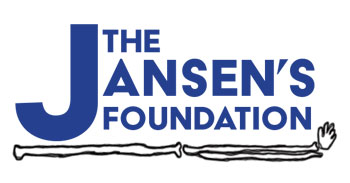 Jansen’s metaphyseal chondrodysplasia (JMC) is a rare autosomal dominant human disorder characterized short-limbed dwarfism due to delayed chondrocyte differentiation and an associated, usually severe hypercalcemia and hypophosphatemia, despite normal or undetectable serum levels of PTH or PTHrP. These abnormalities are caused by mutations in the PTHR1 that lead to constitutive, PTH- and PTHrP-independent receptor activation. Since the PTHR1 is most abundantly expressed in kidney and bone, and in the metaphyseal growth plate, these findings provide a likely explanation for the abnormalities observed in mineral homeostasis and growth plate development associated with this disorder.
Jansen’s metaphyseal chondrodysplasia (JMC) is a rare autosomal dominant human disorder characterized short-limbed dwarfism due to delayed chondrocyte differentiation and an associated, usually severe hypercalcemia and hypophosphatemia, despite normal or undetectable serum levels of PTH or PTHrP. These abnormalities are caused by mutations in the PTHR1 that lead to constitutive, PTH- and PTHrP-independent receptor activation. Since the PTHR1 is most abundantly expressed in kidney and bone, and in the metaphyseal growth plate, these findings provide a likely explanation for the abnormalities observed in mineral homeostasis and growth plate development associated with this disorder.
At birth, some JMC patients appear to be healthy, while others show dysmorphic features which can include micrognathia, prominent eyes, high skull vault, hypertelorism, prominent cheeks, wide cranial sutures, and a high-arched palate. Due to choanal atresia and/or rib fractures, patients often develop post-partum respiratory distress and require intubation. During the first years of life, patients typically decline progressively from their normal growth curves, may have feeding difficulties, recurrent episodes of vomiting and dehydration, and present with short stature and with other findings which may include waddling gait, enlarged joints, prominent supraorbital ridges, frontonasal hyperplasia, and a “bell-shaped” thorax with widened costochondral junctions. The legs, in particular the tibiae, are typically bowed, and are short in comparison to the relatively long arms. Tooth development and enamel formation are affected as well with few cases presenting impacted teeth.
Laboratory findings
In the newborn period, blood calcium and phosphorus concentrations are typically in the upper normal range, while alkaline phosphatase activity, a marker of osteoblast activity, can already be elevated. Severe but asymptomatic hypercalcemia, usually develops during the first months after birth (especially if vitamin D treatment is initiated for suspected rickets), and is most pronounced during infancy and childhood when serum calcium can reach 20 mg/dl. Hypercalcemia is caused
https://healthsavy.com/product/xanax/
through at least two mechanisms: increased tubular reabsorption of calcium in the kidney and markedly increased bone resorption as reflected by increased excretion of urinary hydroxyproline and hydroxypyridinoline, markers of osteoclastic activity. As a result of increased osteoblastic activity, serum alkaline phosphatase activity and osteocalcin concentrations are elevated. After puberty, and coinciding with the radiological improvement of the growth plate abnormalities and with an improvement in tubular calcium reabsorption, blood calcium levels improve, but remain elevated throughout life.
History
In 1934, Murk Jansen described the first case of JMC, a rare, autosomal dominant disorder characterized by short-limbed short stature, which was later shown to develop postnatally due to delayed chondrocyte differentiation. JMC is typically associated with severe and, generally, asymptomatic hypercalcemia and hypophosphatemia, with low-normal or undetectable serum PTH levels. Five different activating PTH1R mutations affecting one of three different amino acid residues have been identified thus far in affected patients, which all cause constitutive, ligand-independent receptor activation. The mutant PTH1Rs thus activate the cAMP/protein kinase A signaling pathway in the kidney, bone, and growth plates in the absence of PTH or PTHrP, thereby causing an abnormal regulation of both mineral ion homeostasis and endochondral bone formation.
Hence, most JMC patients develop biochemical features suggestive of hyperparathyroidism, including elevated serum calcium, low serum phosphorus, and elevated alkaline phosphatase activity, but without elevated PTH or PTHrP levels.
Establishing the diagnosis of JMC during infancy or early childhood can be challenging, especially in the absence of family history and/or overt hypercalcemia.
Text Source:
Nampoothiri, S., Fernández-Rebollo, E., Yesodharan, D., Gardella, T., Rush, E. R., Langman, C. B., and Jüppner, H. (2016). Jansen’s Disease With or Without Hypercalcemia. J Clin EndocrinolMetab. 101(11):4283–4289. doi: 10.1210/jc.2016-2054
Silve C., Jüppner H. (2005). Jansen’s Metaphyseal Chondrodysplasia. Orphanet Encyclopedia. https://www.orpha.net/data/patho/GBuk-JansensMetaphChondrodysplasia.pdf
For more details visit www.thejansensfoundation.org
 Jansen’s metaphyseal chondrodysplasia (JMC) is a rare autosomal dominant human disorder characterized short-limbed dwarfism due to delayed chondrocyte differentiation and an associated, usually severe hypercalcemia and hypophosphatemia, despite normal or undetectable serum levels of PTH or PTHrP. These abnormalities are caused by mutations in the PTHR1 that lead to constitutive, PTH- and PTHrP-independent receptor activation. Since the PTHR1 is most abundantly expressed in kidney and bone, and in the metaphyseal growth plate, these findings provide a likely explanation for the abnormalities observed in mineral homeostasis and growth plate development associated with this disorder.
Jansen’s metaphyseal chondrodysplasia (JMC) is a rare autosomal dominant human disorder characterized short-limbed dwarfism due to delayed chondrocyte differentiation and an associated, usually severe hypercalcemia and hypophosphatemia, despite normal or undetectable serum levels of PTH or PTHrP. These abnormalities are caused by mutations in the PTHR1 that lead to constitutive, PTH- and PTHrP-independent receptor activation. Since the PTHR1 is most abundantly expressed in kidney and bone, and in the metaphyseal growth plate, these findings provide a likely explanation for the abnormalities observed in mineral homeostasis and growth plate development associated with this disorder.


